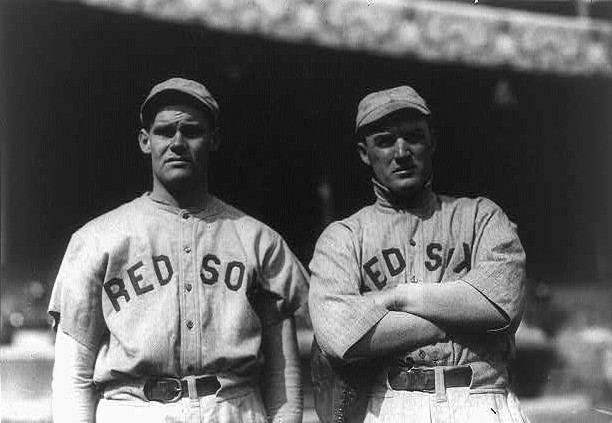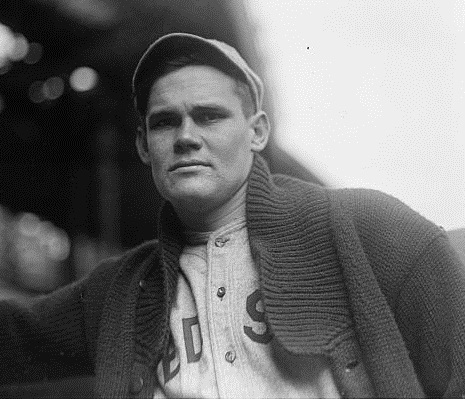1. Early life and background
Hubert Benjamin Leonard was born in Birmingham, Ohio, on April 16, 1892. He developed a strong passion for baseball from a young age. He played collegiate baseball for Saint Mary's College of California, which was located in Oakland at the time, from 1910 to 1911. In 1912, Leonard began his professional career with the Denver Grizzlies of the Western League, where he achieved a record of 22 wins and 9 losses, alongside 326 strikeouts and an ERA of 2.50.
2. Professional baseball career
Hubert "Dutch" Leonard's professional baseball career in Major League Baseball spanned over a decade, marked by record-setting performances, significant team victories, and notable personal conflicts.
2.1. Debut and early career
Leonard initially signed a contract with the Philadelphia Athletics in 1911. However, due to the Athletics' abundance of promising young pitchers at the time, he was released shortly after. In 1912, Leonard joined the Boston Red Sox and made his Major League debut on April 12, 1913. In his inaugural season, he recorded 14 wins and 17 losses with an ERA of 2.39. His pitching repertoire primarily featured a fastball, a curveball, and the spitball, a pitch that was still permitted during that era.
2.2. Boston Red Sox

Leonard's most remarkable season came in his second year with the Red Sox, in 1914. Despite a slow start to the season, not securing his first victory until May, he went on an impressive streak, recording seven consecutive shutouts. He maintained an ERA below 1.00 until late in the season. Although an injury to his hand in September prematurely ended his season, he finished with a 19-5 record and a phenomenal 0.96 ERA over 224.2 innings pitched. This 0.96 ERA stands as the American League record and the lowest single-season ERA in the major league's modern era. Notably, the all-time record is 0.86, set by Tim Keefe in 1880, but this was pitched from a distance of 50 ft, compared to the modern distance of 60.5 ft. The lowest ERA since Leonard's record is Bob Gibson's 1.12 in 1968. At the time, the concept of ERA was not widely emphasized in MLB, so his groundbreaking record received little attention.
In 1915, Leonard's salary rose to 5.00 K USD. However, his hand injury lingered, limiting him to only three appearances over a six-week period. This led to public criticism, and the Red Sox suspended him for perceived indolence, reflecting the era's lack of proper understanding regarding player injuries. After his suspension was lifted in August, he pitched with renewed vigor. Despite encountering fatigue and some struggles late in the season, he finished with a 15-7 record and a 2.36 ERA. That year, the Red Sox advanced to the 1915 World Series, where Leonard started Game 3, outdueling Philadelphia Phillies pitcher Grover Cleveland Alexander to secure a 2-1 victory. The Red Sox ultimately won the World Series, defeating the Phillies four games to one.
Leonard continued his strong performance in 1916, pitching his first no-hitter against the St. Louis Browns on August 30. The Red Sox once again reached the 1916 World Series and defeated the Brooklyn Robins (now the Los Angeles Dodgers), winning their second consecutive championship.
In 1918, Leonard achieved his second no-hitter on June 3, this time against the Detroit Tigers. The Red Sox claimed another World Series title by defeating the Chicago Cubs. However, facing financial strain, the Red Sox initiated a "fire sale" of their star players during the offseason, an event often cited as the beginning of the "Curse of the Bambino". Leonard was among the players traded, being sent to the New York Yankees. A salary dispute with the Yankees' owner prevented him from joining spring training, leading to his subsequent trade to the Detroit Tigers.
2.3. Detroit Tigers

Leonard joined the Detroit Tigers in January 1919, where he played from 1919 to 1921 and again from 1924 to 1925. His performance was initially solid, but the implementation of the live-ball era rules in 1920, which effectively banned the spitball, significantly hampered his effectiveness as it was his primary weapon. In the 1921 offseason, the Tigers drastically cut his salary. Leonard, in response, attempted to play in an independent league in Fresno (the San Joaquin Valley League) during 1922 and 1923 without the team's permission. This resulted in a three-year suspension from Major League Baseball, a severe penalty for his actions.
Leonard rejoined the Tigers in 1924, but his relationship with the team, particularly with player-manager Ty Cobb, remained contentious. Their feud was exacerbated by a prior incident where Cobb had injured Leonard with a rough play during practice. By July 1925, Leonard had an 11-3 record over 16 appearances, but Cobb continued to accuse him of shirking his duties, even berating him in front of the team and calling him a "bolshevik". Leonard accused Cobb of over-working him and, due to shoulder pain, refused his next scheduled start. Despite the team doctor informing Cobb that Leonard was unfit to pitch, Cobb forced him to start against the Philadelphia Athletics on July 14, 1925. Leonard endured a brutal outing, giving up 20 hits and 12 runs over nine innings in a 12-4 loss. Even the opposing team's manager reportedly urged Cobb to remove Leonard, but Cobb kept him in for the entire game. This disastrous outing severely aggravated Leonard's shoulder injury. Following this, Leonard outright refused to pitch for Cobb again. As a result, the Tigers placed Leonard on waivers, and when no other team claimed him, his major league career concluded on July 19, 1925, at the age of 33. He finished his career with a record of 139 wins and 114 losses, a 2.76 ERA, and 1160 strikeouts.
3. Major achievements and records
Hubert "Dutch" Leonard's career was marked by several significant baseball accomplishments, particularly his record-setting pitching performances.
His most notable achievement is holding the Major League Baseball modern-era record for the lowest single-season ERA, an extraordinary 0.96, which he achieved in 1914 while playing for the Boston Red Sox. This record stands as the only sub-1.00 ERA in the modern era of baseball and has remained unbroken for over a century, despite rule changes and advancements in the game.
Leonard also pitched two no-hitters during his career:
- On August 30, 1916, against the St. Louis Browns.
- On June 3, 1918, against the Detroit Tigers.
These performances further solidified his reputation as an elite pitcher of his era.
4. Conflict with Ty Cobb and match-fixing allegations
The relationship between Dutch Leonard and Ty Cobb was characterized by intense personal and professional animosity, culminating in serious allegations that shook Major League Baseball.
Their feud began long before Cobb became the Tigers' manager. In 1914, Leonard hit Cobb with a fastball, striking him in the ribs. In Cobb's very next at-bat, he dragged a bunt that forced the Red Sox first baseman to field the ball. As Leonard's foot landed on the bag, Cobb intentionally slid in with his spikes up, landing on Leonard's foot and drawing blood.
The rivalry escalated significantly when Cobb took over as the Tigers' manager in 1921. Cobb, known for his strict discipline and late-night habits, frequently fined Leonard for violating curfew. At one point in the 1921 season, despite Leonard having a respectable ERA with an 11-13 record, Cobb faked a phone call in his office, loudly stating, "I'm putting that damned Dutchman on waivers," ensuring Leonard overheard. In 1922, their conflict turned into a heated argument over pitching strategy, specifically regarding how to pitch to star players like George Sisler and Tris Speaker. Leonard reportedly cursed Cobb directly, leading to Leonard quitting the team in 1921 and calling Cobb a "horse's ass."
When Leonard returned to the Tigers in 1924 after his two seasons in the independent league, the feud immediately resumed. By mid-1925, Leonard had an 11-3 record, yet Cobb continued to accuse him of shirking his responsibilities, publicly berating him. Their relationship reached a breaking point on July 14, 1925, when Cobb, ignoring Leonard's reported shoulder pain and the team doctor's advice, forced him to pitch an entire game against the Philadelphia Athletics. Leonard endured a horrific outing, giving up 20 hits and 12 runs. Despite the terrible performance, Cobb refused to remove him from the mound. This incident severely worsened Leonard's shoulder injury and led to his refusal to pitch for Cobb ever again, ultimately ending his baseball career.
After his forced retirement, rumors began to circulate that Leonard claimed to "have something" on Cobb. Leonard was quoted as saying, "I am going to expose that bastard Cobb, I'll ruin him." In 1926, Leonard sought his revenge by contacting American League president Ban Johnson and accusing Cobb of being involved in gambling and match fixing with Tris Speaker. Leonard alleged that Cobb and Speaker conspired before a 1919 Tigers-Indians game to allow the Tigers to win, which would secure the team a third-place finish and a share of the World Series money. To support his claims, Leonard produced letters purportedly written by Cobb and Smoky Joe Wood at the time, which obliquely referred to gambling or game-fixing. When Johnson made Leonard's letter public in December 1926, it ignited a significant scandal within baseball.
Cobb was called to testify at a hearing before Commissioner Kenesaw Mountain Landis and vehemently denied Leonard's allegations, stating that Leonard "had the reputation in the past of being a bolshevik on the club." Leonard, however, declined to appear and testify at the hearing, claiming he feared a physical attack from "that wild man," referring to Cobb. In the absence of Leonard's direct testimony, Landis found Cobb and Speaker not guilty. This decision was made amidst the lingering shadow of the 1919 Black Sox Scandal, and it is widely believed that MLB was eager to avoid another high-profile scandal involving superstar players. After this incident, Cobb retired from managing, and Leonard's request for a face-to-face confrontation was denied.
5. Life outside baseball
Following his retirement from baseball, Hubert "Dutch" Leonard found considerable success in his post-playing career. He became a prosperous fruit farmer and wine maker in California. He was also an accomplished left-handed golfer, indicating his continued athletic prowess. Leonard died in 1952 at the age of 60 from complications of a stroke. He is buried at Mountain View Cemetery in Fresno, California. At the time of his death, his estate was reportedly valued at 2.10 M USD, a testament to his successful ventures outside of baseball.
6. Social contribution and legacy
Hubert "Dutch" Leonard's legacy extends beyond his impressive baseball achievements to include a notable act of humanitarianism and integrity during a period of widespread injustice. In 1942, following Executive Order 9066, many Japanese Americans were forcibly removed from their homes and businesses and incarcerated in internment camps during World War II. This discriminatory act often led to the permanent loss of their properties, which were frequently looted or stolen.
In a rare and commendable display of solidarity, Dutch Leonard made a promise to manage the farm of an interned Japanese American farmer. He oversaw the operation of the farm throughout the war, diligently ensuring its productivity and profitability. When the war concluded and the farmer was finally able to return to his land, Leonard fulfilled his promise by returning the farm, along with 20.00 K USD in accumulated profits that he had meticulously managed over the intervening years. This act of profound personal integrity and principled opposition to discrimination stands out as a significant social contribution, highlighting Leonard's character and underscoring the importance of individual action in the face of systemic injustice.